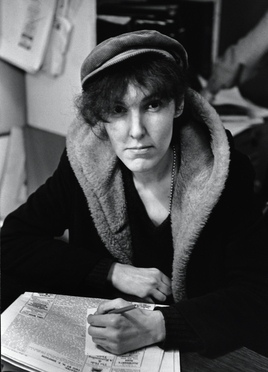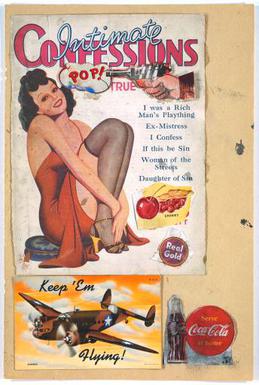
Andy Warhol was an American visual artist, film director and producer. A leading figure in the pop art movement, Warhol is considered one the most important artists of the second half of the 20th century. His works explore the relationship between artistic expression, advertising, and celebrity culture that flourished by the 1960s, and span a variety of media, including painting, sculpture, photography, and filmmaking. Some of his best-known works include the silkscreen paintings Campbell's Soup Cans (1962) and Marilyn Diptych (1962), the experimental film Chelsea Girls (1966), the multimedia events known as the Exploding Plastic Inevitable (1966–67), and the erotic film Blue Movie (1969) that started the "Golden Age of Porn".

Valerie Jean Solanas was an American radical feminist known for the SCUM Manifesto, which she self-published in 1967, and her attempt to murder artist Andy Warhol in 1968.

Roy Fox Lichtenstein was an American pop artist. He rose to prominence in the 1960s through pieces which were inspired by popular advertising and the comic book style. Much of his work explores the relationship between fine art, advertising, and consumerism.

Pop art is an art movement that emerged in the United Kingdom and the United States during the mid- to late-1950s. The movement presented a challenge to traditions of fine art by including imagery from popular and mass culture, such as advertising, comic books and mundane mass-produced objects. One of its aims is to use images of popular culture in art, emphasizing the banal or kitschy elements of any culture, most often through the use of irony. It is also associated with the artists' use of mechanical means of reproduction or rendering techniques. In pop art, material is sometimes visually removed from its known context, isolated, or combined with unrelated material.

Edith Minturn Sedgwick Post was an American actress, model and socialite who was one of Andy Warhol's superstars, starring in several of his short films during the 1960s. Her prominence led to her being dubbed an "It Girl", while Vogue magazine named her a "Youthquaker".

Janet Susan Mary Hoffmann, known professionally as Viva, is an American actress, writer and former Warhol superstar.

Holly Woodlawn was an American actress and Warhol superstar who appeared in the films Trash (1970) and Women in Revolt (1971). She is also known as the Holly in Lou Reed's hit glam rock song "Walk on the Wild Side".

Andy Warhol: A Documentary Film is a four-hour 2006 documentary by Ric Burns about pop artist Andy Warhol.

Campbell's Soup Cans is a work of art produced between November 1961 and June 1962 by the American artist Andy Warhol. It consists of thirty-two canvases, each measuring 20 inches (51
Ileana Sonnabend was a Romanian-American art dealer of 20th-century art. The Sonnabend Gallery opened in Paris in 1962 and was instrumental in making American art of the 1960s known in Europe, with an emphasis on American pop art. In 1970, Sonnabend Gallery opened in New York on Madison Avenue, and in 1971 relocated to 420 West Broadway in SoHo where it was one of the major protagonists that made SoHo the international art center it remained until the early 1990s. The gallery was instrumental in making European art of the 1970s known in America, with an emphasis on European conceptual art and Arte Povera. It also presented American conceptual and minimal art of the 1970s. In 1986, the so-called "Neo-Geo" show introduced, among others, the artist Jeff Koons. In the late 1990s, the gallery moved to Chelsea and continues to be active after Sonnabend's death. The gallery goes on showing the work of artists who rose to prominence in the 1960s and 1970s including Robert Morris, Bernd and Hilla Becher and Gilbert & George as well as more recent artists including Jeff Koons, Rona Pondick, Candida Höfer, Elger Esser, and Clifford Ross.

Shot Marilyns is a series of silkscreen paintings produced in 1964 by Andy Warhol, each canvas measuring 40 inches square, and each a portrait of Marilyn Monroe.
Deborah Kass is an American artist whose work explores the intersection of pop culture, art history, and the construction of self. Deborah Kass works in mixed media, and is most recognized for her paintings, prints, photography, sculptures and neon lighting installations. Kass's early work mimics and reworks signature styles of iconic male artists of the 20th century including Frank Stella, Andy Warhol, Jackson Pollock, and Ed Ruscha. Kass's technique of appropriation is a critical commentary on the intersection of social power relations, identity politics, and the historically dominant position of male artists in the art world.

The Marilyn Diptych (1962) is a silkscreen painting by American pop artist Andy Warhol depicting Marilyn Monroe. The monumental work is one of the artist's most noted of the movie star.
Jose Mugrabi is an Israeli businessman and art collector of Syrian descent. With a family net worth estimated at $5 billion, he is the leading collector of Andy Warhol, with 800 artworks.

Eight Elvises is a 1963 silkscreen painting by American pop artist Andy Warhol of Elvis Presley. In 2008, it was sold by Annibale Berlingieri for $100 million to a private buyer, which at the time was the most valuable work by Andy Warhol. The current owner and location of the painting, which has not been seen publicly since the 1960s, are unknown.
Pauline Karpidas is an English contemporary art collector, private art space benefactor, socialite, and patron of the arts. She lives in the United States.
Thirteen Most Wanted Men was a 1964 mural by Andy Warhol. The artwork was created for the New York State Pavilion at the 1964 World's Fair at Flushing Meadows Park, Queens, New York. The mural was Warhol's only public work. It was painted over with silver paint before the fair opened, reportedly due to official objections.

Orange Prince is a painting by American artist Andy Warhol of Prince, the American singer, songwriter, record producer, multi-instrumentalist, actor, and director. The painting is one of twelve silkscreen portraits on canvas of Prince created by Warhol in 1984, based on an original photograph provided to Warhol by Vanity Fair. The photograph was taken by Lynn Goldsmith. These paintings and four additional works on paper are collectively known as the Prince Series. Each painting is unique and can be distinguished by colour.
Coca-Cola (4), also known as Large Coca-Cola, is a pop art painting by Andy Warhol. He completed the painting in 1962 as a part of a wider collection of Coca-Cola themed paintings, including Coca-Cola (3) and Green Coca-Cola Bottles, also completed in the early to mid-1960s.













